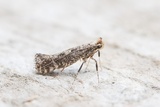Parornix fagivora (Frey, 1861) Species
Last modified: Dec. 10, 2025, 2:12 p.m.
A rare species throughout Belgium.
Details
- Classification
- Family: Gracillariidae > Subfamily: Gracillariinae > Tribus: Parornichini > Genus: Parornix > Species: Parornix fagivora
- Vernacular names
- Beukenzebramot (NL), Beech slender (EN)
- First mention in Belgium
- Fologne E. 1862c. Notes sur quelques lépidoptères observés en Belgique. — Annales de la Société entomologique belge 6: 170–176. On page 174. view page
- Status
-
Native
Distribution
Imago
Forewing greyish with a row of small, inconspicuous, whitish striae along the costa; some brown spots near the inner margin. Identification is very difficult without knowledge of the larval host plant, because of the resemblance with the other Parnornix species; study of the genitalia is necessary.
Mine
The first instar lives in a short, inconspicuous, gallery on the underside of the mine, only visible because of the reddish brown frass line; the gallery soon turns into a brownish blotch. The blackish frass is contained in a corner of the mine. Because the caterpillar spins only a few silks, the mine remains almost flat.
See also gracillariidae.net and bladmineerders.be.
Bionomics
When the caterpillar leaves the mine, it folds the margin of a leaf tip downwards and fastens it with white silken threads. It continues feeding from within this fold, which after a while turns completely brown.
Pupation in the fold, among other fallen leaves on the ground during autumn. The species hibernates in the pupal stage.
The adults rest during the daytime between the foliage or in cracks on the tree trunk. They become active towards dusk and at night. They come to light.
Flight periods
Adults are on the wing from late April towards September in two generations a year.
Observed on
- Host plant (species):
- Fagus sylvatica
The species lives monophagously on Fagus sylvatica.
Habitat
Beech forests, gardens and parks with individual Fagus trees.






